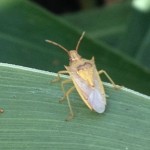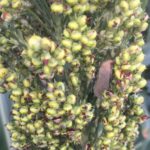Grain  sorghum in the Mid-Coast of Texas ranges from Milk to hard dough. Harvest is just around the corner for some fields. This was noticeable by seeing combines and headers out of the barns getting ready for use.
sorghum in the Mid-Coast of Texas ranges from Milk to hard dough. Harvest is just around the corner for some fields. This was noticeable by seeing combines and headers out of the barns getting ready for use.
We are finding light numbers of stink bugs and headworms in fields across the mid-coast. Continue to check fields weekly for these pests.
One question asked of me this past week involved how to manage stink bugs or headworms  in fields with light sugarcane aphids. My suggestion is not to skip management for the pest you have at economic levels for the pest you may or may not get later. If stink bugs or headworms are above threshold, make the application and prevent the yield or quality loss they cause.
in fields with light sugarcane aphids. My suggestion is not to skip management for the pest you have at economic levels for the pest you may or may not get later. If stink bugs or headworms are above threshold, make the application and prevent the yield or quality loss they cause.
Sugarcane aphids are being found at populations of 0 to 500+ per leaf in sorghum fields of Calhoun, Refugio and Victoria county. Some fields are experiencing increasing numbers while other fields have crashing populations. Generally , Calhoun county sorghum currently has more problems with sugarcane aphids than either Refugio or Victoria. However, this may change tomorrow. Keep a watchful eye on all sorghum fields. Treat when aphids exceed 100 per leaf.
, Calhoun county sorghum currently has more problems with sugarcane aphids than either Refugio or Victoria. However, this may change tomorrow. Keep a watchful eye on all sorghum fields. Treat when aphids exceed 100 per leaf.
Speculation:
The one question we do not have an answer to is “what will the aphid population do if I don’t spray?” If I could answer this question, I may find myself in a more profitable career. In some cases, aphids will continue to increase but in others, the field population may crash. within 7 days.
Another similar question  is “What will the beneficial insects do to the aphid population?” We simply do not have enough information on how the aphids and beneficial insects behave to answer this question. I have read where a lady beetle may consume 20-25 aphids per day and I have seen leaves with as many as 10 lady beetle larvae; but with aphids that may produce 2 offspring per day, how can they keep up? The best I can do is to suggest management action when the aphids exceed 100 aphids per leaf.
is “What will the beneficial insects do to the aphid population?” We simply do not have enough information on how the aphids and beneficial insects behave to answer this question. I have read where a lady beetle may consume 20-25 aphids per day and I have seen leaves with as many as 10 lady beetle larvae; but with aphids that may produce 2 offspring per day, how can they keep up? The best I can do is to suggest management action when the aphids exceed 100 aphids per leaf.
The current economic threshold of 35-125 sugarcane aphids per leaf was developed based on the number of aphids that cause economic grain yield losses. Most of these research projects had economic levels of aphids prior to milk stage sorghum. It stands to reason, later populations may have less of an impact on grain yield but we do not know how different this yield effect may be. What we do know is when aphid numbers get higher, the likelihood of control failures increase. Thus, to prevent an aphid population impacting harvest machinery, I suggest to continue to use the economic thresholds of 35-125 per leaf. I prefer a treatment threshold of 100 per leaf.